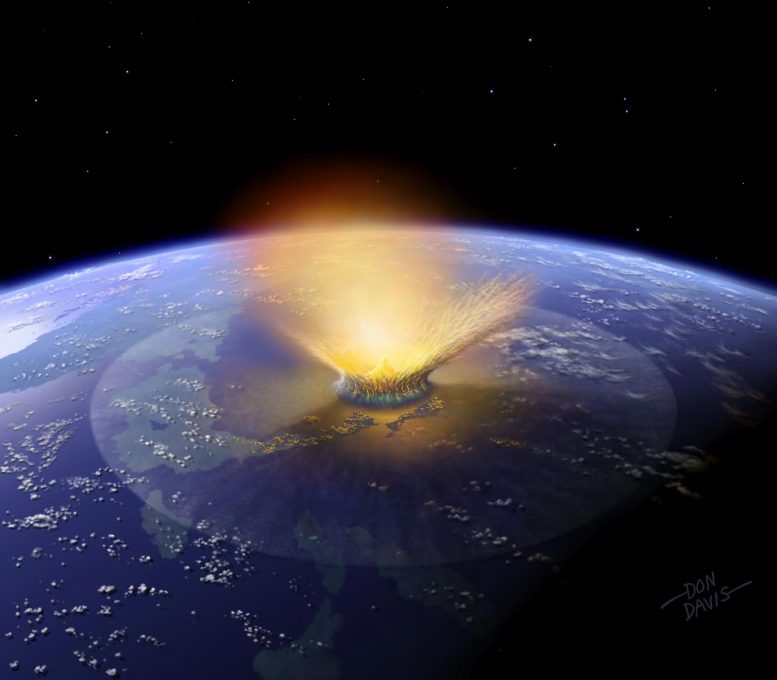
An SwRI team modeled evolutionary processes in the main asteroid belt and discovered that impactors such as the one that ended the reign of the dinosaurs are most likely from the outer half of the main asteroid belt. The team also discovered that delivery processes from that region occur 10 times more often than previously thought. Credit: SwRI/Don Davis
The impactor believed to have wiped out the dinosaurs and other life forms on Earth some 66 million years ago likely came from the outer half of the main asteroid belt, a region previously thought to produce few impactors. Researchers from Southwest Research Institute have shown that the processes that deliver large asteroids to Earth from that region occur at least 10 times more frequently than previously thought and that the composition of these bodies match what we know of the dinosaur-killing impactor.
The SwRI team — including Dr. David Nesvorný, Dr. William Bottke and Dr. Simone Marchi — combined computer models of asteroid evolution with observations of known asteroids to investigate the frequency of so-called Chicxulub events. Over 66 million years ago, a body estimated to be 6 miles across hit in what is now Mexico’s Yucatan peninsula and formed Chicxulub crater, which is over 90 miles across. This massive blast triggered a mass extinction event that ended the reign of the dinosaurs. Over the last several decades, much has been learned about the Chicxulub event, but every advance has led to new questions.
“Two critical ones still unanswered are: ‘What was the source of the impactor?’ and ‘How often did such impact events occur on Earth in the past?’” Bottke said.
To probe the Chicxulub impact, geologists have previously examined 66-million-year-old rock samples found on land and within drill cores. The results indicate the impactor was similar to the carbonaceous chondrite class of meteorites, some of the most pristine materials in the solar system. Curiously, while carbonaceous chondrites are common among the many mile-wide bodies that approach the Earth, none today are close to the sizes needed to produce the Chicxulub impact with any kind of reasonable probability.
“We decided to look for where the siblings of the Chicxulub impactor might be hiding,” said Nesvorný, lead author of a paper describing the research.
“To explain their absence, several past groups have simulated large asteroid and comet breakups in the inner solar system, looking at surges of impacts on Earth with the largest one producing Chicxulub crater,” said Bottke, one of the paper’s co-authors. “While many of these models had interesting properties, none provided a satisfying match to what we know about asteroids and comets. It seemed like we were still missing something important.”
To solve this problem, the team used computer models that track how objects escape the main asteroid belt, a zone of small bodies located between the orbits of Mars and Jupiter. Over eons, thermal forces allow these objects to drift into dynamical “escape hatches” where the gravitational kicks of the planets can push them into orbits nearing Earth. Using NASA’s Pleaides Supercomputer, the team followed 130,000 model asteroids evolving in this slow, steady manner for hundreds of millions of years. Particular attention was given to asteroids located in the outer half of the asteroid belt, the part that is furthest from the Sun. To their surprise, they found that 6-mile-wide asteroids from this region strike the Earth at least 10 times more often than previously calculated.
“This result is intriguing not only because the outer half of the asteroid belt is home to large numbers of carbonaceous chondrite impactors, but also because the team’s simulations can, for the first time, reproduce the orbits of large asteroids on the verge of approaching Earth,” said co-author Marchi. “Our explanation for the source of the Chicxulub impactor fits in beautifully with what we already know about how asteroids evolve.”
Overall, the team found that 6-mile-wide asteroids hit the Earth once every 250 million years on average, a timescale that yields reasonable odds that the Chicxulub crater occurred 66 million years ago. Moreover, nearly half of impacts were from carbonaceous chondrites, a good match with what is known about the Chicxulub impactor.
“This work will help us better understand the nature of the Chicxulub impact, while also telling us where other large impactors from Earth’s deep past might have originated,” Nesvorný said.
The journal Icarus is publishing a paper about this research, “Dark Primitive Asteroids Account for a Large Share of K/Pg-Scale Impacts on the Earth” (Volume 368, 1 November 2021, 114621, Elsevier publications).
Reference: “Dark primitive asteroids account for a large share of K/Pg-scale impacts on the Earth” by David Nesvorný, William F. Bottke and Simone Marchi, 15 July 2021, Icarus.
DOI: 10.1016/j.icarus.2021.114621
arXiv: 2107.03458

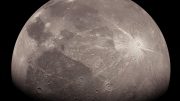
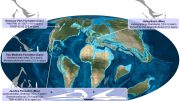
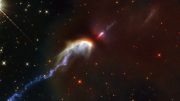
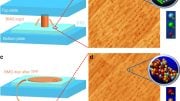

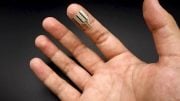


“er eons, thermal forces allow these objects to drift into dynamical “escape hatches” where the gravitational kicks of the planets can push them into orbits nearing Earth”
Are they modeling these thermal forces? Can any stochastic variation in thermal forces lead to a breakout for an asteroid and serve as a threat to Earth?
-fascinating work-kudos to scientists- lots of new leads for resaerch
Good questions!.
The preprint is available [ https://arxiv.org/pdf/2107.03458.pdf ]:
“These models have a common ground. A large number of test bodies is placed onto source orbits and an N-body integrator is used to follow them as they become NEOs.”
“Calibrated many-source NEO models have been used to estimate the observational incompleteness as a function of NEO orbit and size. When the albedo information is folded in, the models also provide intrinsic orbital distributions of dark and bright NEOs and their relative importance for impacts.”
So those are comparative models. But some add physical based simulations:
“… Granvik et al. (2017) followed the orbits of MBAs – as they drift by the Yarkovsky effect (Vokrouhlick´y et al. 2015; the Yarkovsky effect is a radiative recoil force produced by thermal photons emitted from asteroid surface) and enter resonances – and used the results to inform the starting orbits in the NEO model (G18).”
“Here we therefore only consider large MBAs (D > 5 km), for which many of the complicating factors [for radiative effects] discussed above can be brushed aside.”
Fascinating subject. There are two large impact craters in the Hudson Bay area, Quebec, Canada, North and East of James Bay. James Bay may be a crustal fracture/deformation caused by the larger of the two impacts. It was very large. Chicxulub pales in comparison, even factoring-in the Ocean depth off Yucatan. If it were shifted South, it would swallow the greater portion of the Great Lakes. The smaller of the two would have wiped out the greater portion of New York State. One can only wonder if these impacts may have fractured the Laurentian Plate. Pure speculation. There is mounting evidence that a swarm of meteors struck the North American continent, travelling East-to-west, several hundred kilometers North and South of the current US/Canada Border. Can’t say when, but I am really pleased that we missed it. Yet, I would REALLY like to see an occurrence of that magnitude, albeit from a safe distance. Perhaps TIME has provided the safety of distance. Can’t imagine the effect(s) if it were to occur the day after tomorrow. 😵
🦋
Could have happened, but is less likely I think:
“Earth scientists have disagreed about what created the semicircular feature known as the Nastapoka arc that forms a section of the shoreline of southeastern Hudson Bay. … The current general consensus is that it is an arcuate boundary of tectonic origin between the Belcher Fold Belt and undeformed basement of the Superior Craton created during the Trans-Hudson orogeny. This is because no credible evidence for such an impact structure has been found by regional magnetic, Bouguer gravity, or other geologic studies.”
[ https://en.wikipedia.org/wiki/Hudson_Bay ]
The chixculub? These mayans amaze me. Marvel that.
Relevance?
Gene Harvey’s arm was cut off by cops hired by the governor and Breslin… taking the role of the wise guy Garvey spying now dowry spy… Dewey’s? Laughing as an ass and Dwight Eisenhower’s left arm at near the elbow was sundered by those who look.. on insidiously standing near bringing the nazis again to our dear.. saying off man, he’s dars de end, eh ad erastus Corning… received treatment telling the pig pagan… that he is a geraci… gene and dot harvey. Dwight Eisenhower and our freedom, and our future is now, and erastus corning, the mayor, the name from the response to Lincoln re the writ of habeas corpus for the assassination of Lincoln by an actor named clementine van dillingham.. he said to his partners .. carrying then a medical bag with the remedy he said a 25 call colt. These things are all true. And today is the same date the cops attacked my son at 430 in the morning after the atrocity in Albany seen on youtube…. Sheehan, do you usually drop trees on peoples property the run and hide behind some other imp… using names of the mcgee… robert
.. marie francini… And others to deny the city’s liability. Cowards it is abd they laugh at there own pathetic means. Playing games with shrinking idiots of more ewen Cameron and the moronic approach of purging the disabled elderly the unwanted with some immunodeficiency diseass… typical for those in the capital city… of holes beneath.
I’ve never seen anyone remarking on the fact that the Atlantic ocean began to open 65_66 myears ago.
Is there a link with the chicxulub event?
Seems unrelated:
“Pangea had three major phases of breakup. The first major phase began in the Early-Middle Jurassic, taking place between North America and Africa.[5] The second major phase of breakup began in the Early Cretaceous. The South Atlantic Ocean opened around 140 million years ago as Africa separated from South America, and about the same time, India separated from Antarctica and Australia, forming the central Indian Ocean.[citation needed] The final major phase of breakup occurred in the early Cenozoic, as Laurentia separated from Eurasia.[5] As the two plates broke free from each other, the Atlantic Ocean continued to expand.[5]”
[ https://en.wikipedia.org/wiki/Opening_of_the_North_Atlantic_Ocean ]
So the earlier breakups were before and the last started after.
Fabricated inconclusive havering… Zero evidence.. 😁. Might as well blame aliens..!!.
Indeed, you offer zero evidence of zero evidence, while the rest of us can read the paper for the observations and models.
Why do you even try to troll so ineptly?
Bring ’em on…..